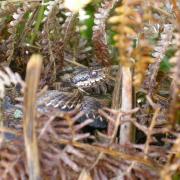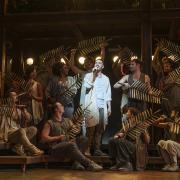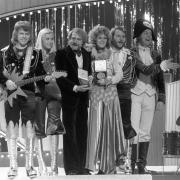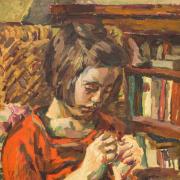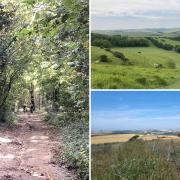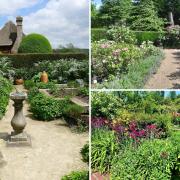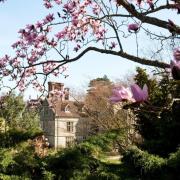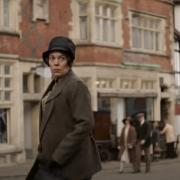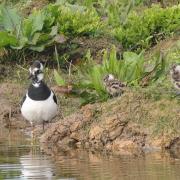Solution for the ‘Gateways’ piece by Tony Ward in the Sussex Life December issue
Unravelling Sussex: Around the County in Riddles by Tony Ward is published by The History Press priced RRP £12.99. To order your copy of the book at the special offer price of £10 plus free p&p, please place your order over the phone by calling Macmillan Distribution on 01256 302699 using code KG7 or email MacmillanDirect@macmillan.co.uk. Offer closes: 26 December 2016.
Where is it? Gateways
Saxon lady, Norman noble, names conjoined.
Time passes, sons to sons,
rising status, rising wealth,
the right to crenellate.
No less than a castle
for a man of the Court.
.
But down the line, at odds.
A King’s displeasure,
a young Lord executed,
his castle confiscated.
.
Reinstated.
Until … the gambling Lord,
his castle lost,
his fortune squandered.
.
A nagging wife, the castle stripped,
‘Who could have done this wicked thing?’
One hundred years and more,
owners came and owners went,
In time of peace, in time of war.
.
Restoration, transformation.
The flight from city lights, to seek the stars.
Dark skies found, but all too soon
the dark skies lost.
Adrift once more.
.
The unsuitable suitor, plans rejected.
The scholar saviour, plans accepted,
The castle gifted.
A gateway to the world.
.
Gardens, sundials, butterflies and bees.
Concerts and carriages, Feathers and Flights,
Wizards and giants, minstrels and knights.
The castle a stage, and still in the wings …
.
Reflectors, Refractors,
the children’s delight.
Awestruck by day
and star-struck by night.
Solution – Herstmonceux Castle and The Observatory Science Centre.
Explanation of embedded clues
The poem’s title ‘Gateways’ connects to these linked sites in three ways. The castle is now the home of the Bader International Study Centre established by Queen’s University, Ontario, Canada. Queen’s describes the facility as a ‘Gateway to the World’. The Observatory telescopes provide a ‘gateway to the stars’ and the many interactive hands-on exhibits in the Science centre open new ‘gateways’ for children to learn about science in action.
The earliest archaeological evidence of activity on the Herstmonceux site dates back to the Romans. The first written evidence though appears in William the Conqueror’s Domesday book. William granted tenancy of the manor at ‘Herst’ to ‘Wilbert’, a favoured supporter. The first line of the poem picks up the story around the year 1200. This is significant because, by marriage, this was when the name ‘Herstmonceux’ was to appear. It also reflected the coming together of the two cultures existing in the area at the time.
A Saxon Lady, Idonea de Herste (tr. ‘of the wooded hill’) married a Norman nobleman, Ingelram de Monceux. The manorial estate became known locally first as the ‘Herste of the Monceux’, then over time this became shortened to Herstmonceux.
“Time passes, sons to sons, / rising status, rising wealth”. The estate passed through the male line for six generations until 1330, when the estate passed to the sister of the final son of the line. Maud de Monceux married well, Sir John Fiennes, a Sussex Knight, and so commenced another son to son sequence of owners. With each generation, the family enjoyed “rising status, rising wealth”. By the start of the 15th century heirs to the line were first to be found fighting alongside King Henry V at Agincourt (1415) and subsequently serving as Treasurer of the Household of King Henry VI.
With inherited wealth, a well-paid job, and influence at Court, Sir Roger Fiennes successfully petitioned the King for “the right to crenellate” (permission to fortify his Manor House). He needed a home befitting a man of his position. Building started in 1441 with a budget of £3,800. To give some idea, an equivalent building project today would cost around £22 million.
The building at that time was the largest private home in England. It was built when castles were no longer being built for primarily defensive purposes but as shows of wealth. Grandeur and comfort were the key attributes. As a fortification it would have been next to useless. The
arrow slits and gun ports were impractically sited and canons, even of that vintage, could demolish the walls with ease. Some architectural historians would prefer to classify Herstmonceux as a ‘Mansion’ even though it has the outward appearance of a castle.
Another feature which sometimes puzzles visitors as to the age of the castle is the fact that it is constructed of brick rather than stone. Herstmonceux was one of the first of only a handful of major buildings of its period constructed using this newly fashionable (French) method of construction, a revival from Roman times. As Simon Jenkins points out in England’s Thousand Best Houses, this was ‘long before such upstarts as Hampton Court’. Herstmonceux was built less than sixty years after that other notable moated Sussex Castle, Bodiam, and yet in comparison it appears considerably more ‘modern’.
Verse 2 records an event a century later. Sir Thomas Fiennes, now also bearing the title Lord Dacre, acquired by the family through an earlier marriage, fell foul of King Henry VIII. He was found guilty of poaching the King’s deer, during which a gamekeeper was killed. “A young Lord executed, / his castle confiscated”.
The estates were not “reinstated” until Queen Elizabeth I came to the throne. The next 150 years were fairly uneventful. The family prospered once more, avoiding any serious entanglement in the English Civil Wars (1642-1651). During the Restoration (1660-1685) they spent significantly on ‘home improvements’ – new fireplaces, Grinling Gibbons carvings, even a large new bay window overlooking the moat. This was to improve the view for Lady Dacre, a daughter of King Charles II. So far so good, but in 1708 the good life came to an end.
“The gambling Lord, / his castle lost, / his fortune squandered”. Thomas Leonard (the name-change from Fiennes to Leonard had been due to marriage back in 1594) was a disaster. The latest round of home improvements ran well over budget, he was a reckless gambler and spent, literally, a fortune enjoying life at the Restoration court. The family was bankrupted. The estate was sold to a lawyer of Lincoln’s Inn in London, George Naylor. The year was 1708. The price was £38,000 (equivalent to about £8 million today).
Worse was to come. In 1775, the castle passed to a half-brother, the Rev. Robert Hare. Henrietta Naylor was his second wife. Upon the Rev. Hare’s death, the castle would pass to the eldest son of his first marriage. Henrietta and the children of her own first marriage would be homeless. She persuaded her husband to consider building a second house, Herstmonceux Place, to be settled upon her, on a higher site within the park. In 1777, her chosen architect for the proposed new house, Samuel Wyatt, was instructed to carry out an assessment of the condition of the castle. Despite another opinion to the contrary he declared it to be beyond economical repair. Henrietta got her way.
“A nagging wife, the castle stripped”. The interior of the castle was gutted to provide materials to build the new house – the staircase, floors, doors, window-frames, timbers, even the bricks were recycled. Today we might applaud this ‘green’ approach, but in this case the destruction was condemned by contemporary writers as an unnecessary desecration. According to one account, recalled by Peter Brandon in The Discovery of Sussex, in later life Henrietta did show signs of remorse. Perhaps suffering from dementia, she is said to have repeatedly wandered around the ruined castle exclaiming, “Who could have done this wicked thing?”
The writer Louis J. Jennings in his 1878 ‘travel book’, Field Paths and Green Lanes, reported that ‘The park has a bare and pillaged look, the fine trees which were formerly its pride having long since been cut down and sold’. It wasn’t only the castle building that had suffered. Avenues of mature Spanish chestnut trees had once criss-crossed the estate. There are just a few survivors today, by the ‘Chestnuts’ tea room, and along ‘Chestnut Walk’ in the woods. During the “One hundred years and more” that the castle remained a romantic ruin, visitors, including notables such as Wiiliam Wilberforce, J.M.W. Turner and Henry James, could have also taken tea in an earlier incarnation of ‘Chestnuts’, the Victorian tea gardens.
“Owners came and owners went”. Restoration didn’t commence until 1910, continuing during the ownership by the eccentric MP, Colonel Claude Lowther then by a wealthy American couple, Reginald and Iva Lawson. Restoration was finally completed by Walter Godfrey during the ownership (1933 -1946) by Sir Paul Latham. Work had continued “In time of peace, in time of war”. Luckily the castle largely escaped damage during World War 2, acting as safe storage for an insurance company’s records and housing an RAF camp together with a large air-raid shelter. Although at times strafed by German planes, there was no bomb damage.
“Transformation” happened in 1946 with the sale of the estate to HM Admiralty to provide a new ‘dark skies’ site for the Royal Greenwich Observatory. Increasing light and smoke pollution had made it impossible to continue the full range of observations at Greenwich. Relocation of staff and equipment started in 1947 and was complete by 1958. At its peak over 200 people worked at The Observatory. Thirty years on however, it had become obvious that the light pollution from nearby Eastbourne had also rendered this site impractical. The Observatory was again relocated, this time to Cambridge, in 1990. Although several of the telescopes in the six green Domes remain, the most impressive, the 100-inch aperture Isaac Newton Telescope had earlier been moved to the clear skies of La Palma in the Canary Islands in the 1970s.
“The unsuitable suitor, plans rejected” was a Developer who purchased the castle from the Government in 1989 with the intention of converting it to a Hotel and Golf Resort. Thankfully this plan was thwarted by a Society set up by local residents. What was now to be done?
Enter “The scholar saviour”. A wealthy Canadian philanthropist and his wife, who had connections with Sussex, came to hear of the castle’s availability. In 1993 Drs Alfred and Isabel Bader purchased the estate and donated it to Dr Alfred Bader’s Alma Mater, Queen’s University, based in Ontario, Canada. Queen’s had been established in 1841 by a Royal Charter issued by Queen Victoria. The idea was that Herstmonceux Castle would become the base for a centre for international education, open to students worldwide. The Bader International Study Centre, as it is now known, is now well established, promoting global citizenship. As one student said, in a video interview, “My time here has changed how I view the world”.
Dr Alfred Bader’s story is truly inspiring. As a Jewish teenager in Austria, following Kristallnacht (the Nazis attack on synagogues, Jewish homes and businesses) he was rescued, aged 14, in 1938, as part of the Kindertransport scheme. Once in England, he attended East Hove Senior School for Boys and Brighton Technical College. Two years later he was sent to an internment camp near Montreal, Canada. Another two years of study and he gained admission to Queen’s University where he gained first degrees in Engineering Chemistry, in History, and an M.Sc. in Chemistry. Harvard followed and more degrees, an M.A. in Chemistry and a Doctorate in Organic Chemistry. He then started his own chemical supply company in his garage (shades of the early days of the 1970s computing entrepreneurs). This grew into the international Aldrich Chemical Company. Dr Bader was a multi-millionaire. He was forever grateful to Queen’s who had admitted the young refugee where other Universities had turned him down.
He first met his future wife Isabel, a Protestant, in 1949, on board the SS Franconia en route to Liverpool. After 9 days together, in London, Alfred proposed. Following a year of deep consideration however Isabel sadly decided that their different religious backgrounds would be an insurmountable obstacle. Alfred married another, life happened. Then twenty-five years later they came across each other again in England. During all that time Isabel had been teaching in Bexhill. They married. They travelled extensively, pursuing their interests in art, “investing” in research and scholarship and in Alfred’s case “trying to help chemists”.
The Baders are internationally known as art collectors (Old Masters) and philanthropists. Besides the gift of Herstmonceux Castle, donations have included three Rembrandts, the funding of Academic Chairs, and a $31 million Performing Arts Centre. The University of Sussex is among nine Universities internationally to have awarded Dr Bader Honorary Doctorates.
The penultimate verse of the poem identifies a few of the many facilities and events that the public can enjoy today when visiting the Gardens and Grounds of Herstmonceux Castle. A particular highlight is England’s Medieval Festival held annually over the August Bank Holiday weekend. The “Wizards and giants, minstrels and knights” are just a few of the spectacles on offer. Subject to availability, it is also possible to book a guided tour of some of the interior of the castle, usually over the lunch times on selected days of the week.
The final verse identifies some of the telescopes, “Reflectors, Refractors”, still in their green Domes “in the wings”, sharing the estates grounds. The Observatory Science Centre was established after the departure of the Royal Greenwich Observatory to their new home in Cambridge. It is a wide-ranging interactive science centre, not just astronomy. Intended primarily for school-aged children, “awestruck by day / and star-struck by night”, it is a great day out for all the family.
Acknowledgement of sources
• Herstmonceux Castle Gardens & Grounds, Visitors leaflet.
• Simon Jenkins, England’s Thousand Best Houses, Allan Lane, 2003 (p. 773).
• Louis J. Jennings, Field Paths and Green Lanes, 3rd Edition, John Murray, 1878 (pp. 54-55).
• Peter Brandon, The Discovery of Sussex, Phillimore, 2010 (p. 131).
• Mark Broad, Sussex under the Stars, Sussex History, Magnet Magazine, February 2016 (pp. 38-39).
• www.herstmonceux-castle.com (The official website)
• en.wikipedia.org/wiki/Herstmonceux_Castle (contains a chronological list of owners)
• www.solarnavigator.net/history/herstmonceux_castle.htm (brief historical details, but with useful references)
• www.herstmonceux.com (Details of England’s Medieval Festival held annually at Herstmonceux Castle over the August Bank Holiday weekend)
• www.queensu.ca/encyclopedia/b/bader-alfred-and-isobel (The story of Drs. Alfred and Isabel Bader, the philanthropists who bought Herstmonceux Castle and gifted it to Queen’s University, Canada, for an International Study Centre)
• www.the-observatory.org (The official Observatory website, with useful links at the foot of the home page)
• en.wikipedia.org/wiki/Herstmonceux_Castle#Royal_Greenwich_Observatory
• Relevant websites found by searches for ‘Herstmonceux Castle’, ‘Queen’s University, Montreal’, ‘Dr Alfred Bader’, ‘Herstmonceux Observatory’.



